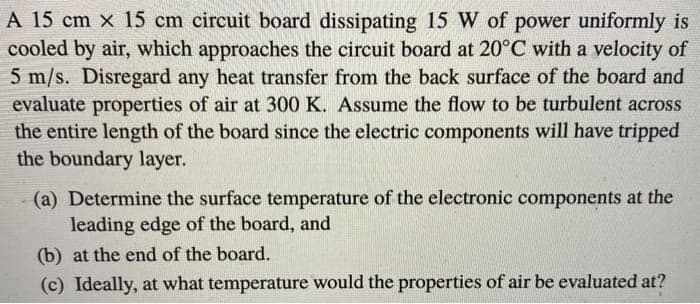A 15 cm x 15 cm circuit board dissipating 15 W of power uniformly is cooled by air, which approaches the circuit board at 20°C with a velocity of 5 m/s. Disregard any heat transfer from the back surface of the board and evaluate properties of air at 300 K. Assume the flow to be turbulent across the entire length of the board since the electric components will have tripped the boundary layer. (a) Determine the surface temperature of the electronic components at the leading edge of the board, and (b) at the end of the board. (c) Ideally, at what temperature would the properties of air be evaluated at?
A 15 cm x 15 cm circuit board dissipating 15 W of power uniformly is cooled by air, which approaches the circuit board at 20°C with a velocity of 5 m/s. Disregard any heat transfer from the back surface of the board and evaluate properties of air at 300 K. Assume the flow to be turbulent across the entire length of the board since the electric components will have tripped the boundary layer. (a) Determine the surface temperature of the electronic components at the leading edge of the board, and (b) at the end of the board. (c) Ideally, at what temperature would the properties of air be evaluated at?
Principles of Heat Transfer (Activate Learning with these NEW titles from Engineering!)
8th Edition
ISBN:9781305387102
Author:Kreith, Frank; Manglik, Raj M.
Publisher:Kreith, Frank; Manglik, Raj M.
Chapter5: Analysis Of Convection Heat Transfer
Section: Chapter Questions
Problem 5.65P
Related questions
Question

Transcribed Image Text:A 15 cm x 15 cm circuit board dissipating 15 W of power uniformly is
cooled by air, which approaches the circuit board at 20°C with a velocity of
5 m/s. Disregard any heat transfer from the back surface of the board and
evaluate properties of air at 300 K. Assume the flow to be turbulent across
the entire length of the board since the electric components will have tripped
the boundary layer.
(a) Determine the surface temperature of the electronic components at the
leading edge of the board, and
(b) at the end of the board.
(c) Ideally, at what temperature would the properties of air be evaluated at?
Expert Solution
This question has been solved!
Explore an expertly crafted, step-by-step solution for a thorough understanding of key concepts.
This is a popular solution!
Trending now
This is a popular solution!
Step by step
Solved in 3 steps with 6 images

Knowledge Booster
Learn more about
Need a deep-dive on the concept behind this application? Look no further. Learn more about this topic, mechanical-engineering and related others by exploring similar questions and additional content below.Recommended textbooks for you

Principles of Heat Transfer (Activate Learning wi…
Mechanical Engineering
ISBN:
9781305387102
Author:
Kreith, Frank; Manglik, Raj M.
Publisher:
Cengage Learning

Principles of Heat Transfer (Activate Learning wi…
Mechanical Engineering
ISBN:
9781305387102
Author:
Kreith, Frank; Manglik, Raj M.
Publisher:
Cengage Learning